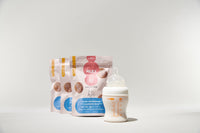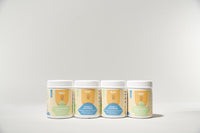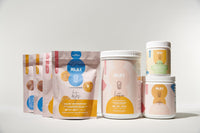As a new mom, you’ve got a lot on your plate--from the moment you bring baby home from the hospital, you’re faced with various decisions such as if you should go back to work, when to go back to work, whether or not you should breastfeed...the list goes on and on!
While there are so many different opinions on these topics, the most important thing to remember is to always focus on what’s best for you and your baby. No one is better equipped to make these decisions than you!
In today’s post, we’re going to be focusing on helpful tips for breastfeeding after returning to work. For many new moms, their #1 concern when it comes to going back to work is their milk supply. So, if you’re getting ready to head back to the office after having your little one, these tips are for you!
Understanding the Benefits of Breastfeeding
If you’ve made the decision to breastfeed, know that while it might be a challenge especially when going back to work, but there are great benefits for both you and your baby. Breast milk provides the ideal nutrition for infants, and according to WebMD, it has the perfect mix of vitamins, protein, and fat--everything your baby needs to grow. Here’s a quick overview of how breastfeeding can benefit your baby:
- Easier to digest than infant formula
- Contains antibodies that can help your baby fight off viruses and bacteria
- Lowers your baby’s risk of allergies and asthma
- Has been linked to fewer ear infections, respiratory illnesses, hospitalizations and trips to the doctor
- Helps you and your baby to bond
Additionally, breastfeeding can benefit you as mom! It releases the hormone oxytocin, which helps your uterus return to its pre-pregnancy size and can reduce uterine bleeding after birth. Breastfeeding has also been shown to lower your risk of ovarian cancer and even osteoporosis.
With all of this being said, you can rest assured that making the decision to breastfeed is one that can provide amazing benefits for both you and your little one.
Doing your Research
When it comes to breastfeeding, there are so many amazing resources out there, from classes to lactation specialists, to support groups. Many hospitals offer breastfeeding classes to new moms where you can learn how to position your baby, get tips on how to continue breastfeeding when returning to work, and ask any questions you may have. What’s great about these classes and breastfeeding support groups is that you can meet other women who may be going through similar experiences you are. Being connected to a community during this time is crucial!So what about a lactation specialist? These professionals have been certified by the International Board of Certified Lactation Consultants (you’ll notice the letters IBCLC will appear after their name). Lactation specialists offer everything from tips on returning to work, teaching a new mom how to position her baby, to how to increase milk supply or handle breast infection. Meeting with a specialist can put your mind at ease and allow you to ask any questions you may have about making the transition back to work. After all, they’re experts!
If you’re wondering where to find a lactation consultant, consider browsing the International Lactation Consultant Association Directory. Here, you can search for a consultant based on location, name, additional certifications or credentials, and practice setting.
Child Care
For many moms, one of the most stressful aspects of going back to work is finding reliable and safe childcare for their baby. Whether you decide to explore daycare or hire a private sitter, make sure the option you choose is conducive to breastfeeding. Your sitter or daycare center will need to be able to understand and support your baby’s schedule and needs, and they’ll need to be knowledgeable about the proper handling, storage, and feeding of breast milk.
Remember that the right decision when it comes to childcare is what works best for you and your baby. When you’re comfortable and confident in the decision you’ve made, you will experience less stress, which is something that can have a negative impact on milk supply.
Selecting the Right Pump
Pumping is the way you’ll provide your baby with breast milk when you’re away at work. However, it’s important to know that not all pumps are created equal! There are 3 different types of pumps:
- For occasional use
- For regular use
- For mothers who haven’t yet established a milk supply and whose baby is less than 8 weeks old
Manual pumps are best for occasional use (once or twice a week). Small, motorized pumps are best for moms who are separated from their babies for 1-2 feedings, once or twice a week. If you’ve already established a good milk supply and your baby is nursing well but you’ll be separated from your baby because of work, you will need an electric double pump. For mothers who haven’t established a milk supply and have a baby less than 8 weeks old, you will most likely need a hospital-grade electric double pump.
If you’re a mom who knows you’ll be heading back to work, you’re probably thinking, ‘When should I buy a pump?’ The answer depends on your circumstances, but it can be beneficial to buy a personal pump before your baby is born. This way, you can use it for comfort during the early weeks if you need to and get familiar with using it.
Establishing Your Work Routine
Heading back to work can be scary, but remember communication is key. It’s important for your employer and coworkers to understand your situation and needs. If possible, Womenshealth.gov recommends talking to your employer before going on maternity leave so they know about your plans to breastfeed.
Your boss can always visit Supporting Nursing Moms at Work: Employer Solutions to learn tips on supporting nursing mothers at work. It’s also important to note that you have rights under the federal Break Time For Nursing Mothers law to be given reasonable break time to express breast milk for your nursing child for up to one year.
In regards to pumping at work, you will need to pump at the times you would feed your baby normally. In the first few months, babies generally need to be fed 8-12 times in 24 hours. Once you’re used to using your breast pump, pumping can take anywhere from 10-15 minutes. You may need to pump up to 2-3 times at work each day to make enough for your baby while you are away!
Research shows that breastfed babies between 1 and 6 months old take in an average of 2-6 ounces per feeding, and as your baby gets older, your breastmilk will change to meet his or her needs. While it’s important to give your baby milk that aligns with their development process, you can build a stash for 1-2 days or up to a week as your childcare provider will need to feed baby while you are gone.
Finally, breast milk is food and must stay refrigerated. You can always talk to your boss about storing it in an employee refrigerator or store it in a cooler with ice packs! If you do choose to store it at work, be sure to clearly label it and place it in the back of the office fridge (remember, it can only be stored here for up to 5 days!). Or, if you do not have access to a fridge, you can always choose to store it in a cooler. Many companies make coolers specifically for breastfeeding moms and they’re super handy! Some of our favorites are listed below.
- Medela Breast Milk Cooler Set
- Mommy Knows Best Breast Milk Cooler Bag Set
- Madenal Breast Pump Travel Set
Many companies specialize in making products for breastfeeding moms and babies, including plastic bags for breast milk. These types of plastic bags are more durable than those used in baby bottles and are easy to seal and label. Many of them can also be attached directly to your pump, and they are designed to protect the quality of your milk. Not sure where to look? Here are a few great options:
Using a hard container is another way to store your breast milk. These containers should be made of either glass or hard-sided, clear plastic. Make sure the container you use has a secure, one-piece top! Here are a few recommendations:
- Medela Breast Milk Freezing & Storage Containers
- Philips AVENT Breast Milk Storage Cups
- Sage Spoonfuls Glass Breast Milk Storage
Remaining Stress-Free (at least try haha)
A little bit of stress is inevitable as you adapt to your new daily routine, however, it’s best to remain as stress-free as possible, as this can hinder milk production! Studies have shown that stress can slow the release of oxytocin to the bloodstream of a breastfeeding mother, so if you’re struggling to produce milk because of low oxytocin levels, peace, calm and relaxation is key.
On the other hand, research has also found that breastfeeding can reduce negative moods and stress because nursing results in the release of oxytocin into your bloodstream. Since the baby’s sucking stimulates milk production, if you keep nursing you are likely to keep producing milk. Regardless, if you are struggling with low milk production, it’s best to consult with a lactation specialist.
Stay Hydrated
Staying hydrated is crucial while breastfeeding. While drinking more water doesn’t necessarily mean you’ll produce more milk, not getting enough on a daily basis can cause your milk production to decrease. The average adult should be drinking at least 64 ounces per day, and pregnant and breastfeeding women should be drinking at least 32 extra ounces per day.
In addition to staying on top of all of your other responsibilities, how are you supposed to stay hydrated? Here are a few tips:
- Keep fluids with you at all times. If you don’t have water with you at all times, you’re much more likely to forget to stay hydrated! So, make sure you always have your water bottle with you, whether it’s at work, when you’re out and about, and even at home.
- Follow a schedule. Creating a checklist will help you to track your water intake and make sure you’re drinking enough throughout the day. Consider setting goals for yourself, like drinking 40 ounces by lunchtime.
- Choose your liquids wisely. If you’re not a big water drinker, consider other options like coconut water, which is super hydrating! However, be careful not to opt for tea or coffee (these can have an adverse effect on hydration) or super sugary drinks.
- Eat foods high in fluids. You can also stay hydrated by choosing foods that are high in fluids! Not only are fruits and vegetables great for your health, but they’re packed with hydration.
Nurse when You Can
While pumping is an amazing option while you’re away from your baby, try to nurse whenever you can. Why? Direct breastfeeding is amazing because it strengthens the bond you have with your baby. Skin to skin contact is good for development, and it gives you time to relax and spend one-on-one time with your baby.
Additionally, direct breastfeeding will save you the hassle of having to pack and sterilize bottles and worry about keeping them at the right temperature. It’s so important for moms who pump and bottle feed to know about the safety regulations of storing and serving breast milk!
Finally, your breast milk changes to meet your baby’s needs, and your baby must direct breastfeed occasionally to receive these benefits! A mom’s milk tailors her baby’s needs in ways more than just caloric intake--a 2013 study found that when a baby is ill, the numbers of leukocytes in its mother's breast milk spike, providing baby with the nutrients they need to fight off the illness!
Nourishing Your Body
It’s no secret that your diet plays a major role during pregnancy, but did you know that it’s also crucial when breastfeeding? Your body is working extremely hard during this time and requires specific nutrients to be able to provide your baby with what he or she needs. Here are some important nutrients to make sure you’re getting enough of:
- Protein
- Vitamin A
- Folic Acid
- Iron
- Iodine
- Calcium
- Zinc
- Vitamin B12
While supplements are a great way to ensure you’re getting the nutrients you need, eating a nutrient-rich diet can also support your milk production. Here at Majka, we believe that feeling good starts from the inside out, which is why we’ve created a line of products with pregnant and nursing moms in mind. Our Lactation Bites and Nourishing Lactation Protein Powder are designed to fill in the nutritional gaps experienced by many moms, and they’re also easy to take on-the-go because we know your nutrition often gets put on the backburner.
Here are some quick and easy recipes you can make to boost your breast milk supply (they can be enjoyed by the whole family, too!):
- The Ultimate Lactation Smoothie Recipe
- DIY Majka Protein Energy Balls
- Carrot Cake Lactation Smoothie
If you try any of these recipes at home, let us know by tagging us at @lovemajka and using #lovemajka on Instagram!
References:
- “Breastfeeding Overview.” WebMD, WebMD, https://www.webmd.com/parenting/baby/nursing-basics#1-2
- “Choosing a Breast Pump.” Breastfeeding USA, 31 Mar. 2016, breastfeedingusa.org/content/article/choosing-breast-pump.
- “Breastfeeding and Going Back to Work.” Womenshealth.gov, 3 May 2017, www.womenshealth.gov/breastfeeding/breastfeeding-home-work-and-public/breastfeeding-and-going-back-work.
- BabyCenter Editorial Team. “Is It True That Stress Can Cause Breast Milk to Dry up?” BabyCenter, 3 Apr. 2018, https://www.babycenter.com/404_is-it-true-that-stress-can-cause-breast-milk-to-dry-up_10336898.bc.
- “Transporting and Storing Breast Milk | Ask Dr Sears®.” Ask Dr Sears, www.askdrsears.com/topics/feeding-eating/breastfeeding/while-working/storing-transporting-breast-milk.
- Hiser, Rachel. “The Pros & Cons of Breastfeeding vs. Pumping.” MomTricks, MomTricks, 20 Feb. 2018, www.momtricks.com/breastfeeding/breastfeeding-vs-pumping/.
- Becker, Hollee Actman. “Amazing! Viral Photo Shows How Breastmilk Changes for Baby's Needs.” Parents, Parents, 6 Dec. 2017, https://www.parents.com/baby/all-about-babies/amazing-viral-photo-shows-how-breastmilk-changes-for-babys-needs/



















